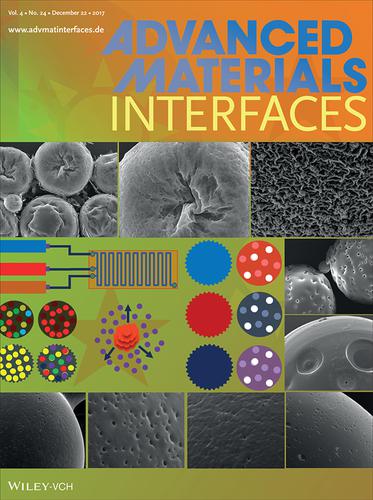当前位置:
X-MOL 学术
›
Adv. Mater. Interfaces
›
论文详情
Our official English website, www.x-mol.net, welcomes your
feedback! (Note: you will need to create a separate account there.)
Structured Particulate Materials: Surface Wrinkling and Porosity of Polymer Particles toward Biological and Biomedical Applications (Adv. Mater. Interfaces 24/2017)
Advanced Materials Interfaces ( IF 4.3 ) Pub Date : 2017-12-21 , DOI: 10.1002/admi.201770125 Nikunjkumar R. Visaveliya 1, 2 , Christopher W. Leishman 2 , Kara Ng 2, 3 , Nicolas Yehya 2 , Nelson Tobar 2 , Dorthe M. Eisele 2, 3 , Johann Michael Köhler 1
Advanced Materials Interfaces ( IF 4.3 ) Pub Date : 2017-12-21 , DOI: 10.1002/admi.201770125 Nikunjkumar R. Visaveliya 1, 2 , Christopher W. Leishman 2 , Kara Ng 2, 3 , Nicolas Yehya 2 , Nelson Tobar 2 , Dorthe M. Eisele 2, 3 , Johann Michael Köhler 1
Affiliation

|
Polymer particles of nanometer and micrometer size with specific surface properties such as surface wrinkling and porosity are of versatile interest in biomedical and biological applications. These structured particles can be produced through microfluidics, and they present the large surface area and allow excellent interactions with active objects for robust functions such as high loading and controlled release of cargos in drug delivery, scaffolds for tissue engineering, and for the enhanced cell‐material interfacial interactions. More details can be found in article number 1700929 by Nikunjkumar R. Visaveliya, Dorthe M. Eisele, Johann Michael Köhler and co‐workers.

中文翻译:

结构化颗粒材料:聚合物颗粒在生物和生物医学应用中的表面起皱和孔隙率(Adv。Mater。Interfaces 24/2017)
具有特定表面性质,例如表面起皱和孔隙率的纳米和微米尺寸的聚合物颗粒在生物医学和生物应用中受到广泛关注。这些结构化的颗粒可以通过微流体产生,它们具有较大的表面积,并可以与活性物质进行出色的相互作用,从而实现强大的功能,例如高负荷和药物输送中货物的受控释放,组织工程用支架以及增强的细胞功能。物质界面相互作用。有关更多详细信息,请参见Nikunjkumar R. Visaveliya,Dorthe M. Eisele,Johann MichaelKöhler和其同事的文章1700929。

更新日期:2017-12-21

中文翻译:

结构化颗粒材料:聚合物颗粒在生物和生物医学应用中的表面起皱和孔隙率(Adv。Mater。Interfaces 24/2017)
具有特定表面性质,例如表面起皱和孔隙率的纳米和微米尺寸的聚合物颗粒在生物医学和生物应用中受到广泛关注。这些结构化的颗粒可以通过微流体产生,它们具有较大的表面积,并可以与活性物质进行出色的相互作用,从而实现强大的功能,例如高负荷和药物输送中货物的受控释放,组织工程用支架以及增强的细胞功能。物质界面相互作用。有关更多详细信息,请参见Nikunjkumar R. Visaveliya,Dorthe M. Eisele,Johann MichaelKöhler和其同事的文章1700929。












































 京公网安备 11010802027423号
京公网安备 11010802027423号